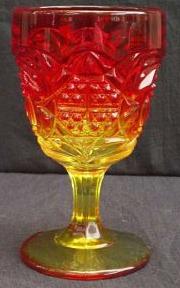
Guide to Collecting Glassware, Part 2
Written by Rosemary Trietsch
GLOSSARY
OF GLASS TERMS
When, in the course of human in events, it becomes necessary for one
glass collector to dissolve the cloud of uncertainty that surrounds some aspect
of his collection, to dispel the myths and assumptions in favor of the truth,
and to search for answers that have until now escaped him, a decent respect to
the opinions of mankind requires that he ask someone else, “What the heck
is this?” We hold this truth to be self-evident: that all collectors
are initially confused by the following terms when they research their
treasures.
Whether you’re new to glass collecting or have already amassed hundreds
of pieces, we hope this glossary of glass terms will help you to understand more
about the glass you collect.

Amberina Goblet
Acid
finish -
A matte finish on glassware that is achieved by exposing the entire surface of a
piece to acid fumes during the finishing process.
More rarely, the finish is obtained by the use of a mechanical grinding
wheel. (See Satin)
Amberina – glass that shades from red at the top to amber as you approach the base. Cooling and reheating the top portion of the glass created the shadings in the finished product.
Annealing
– the
gradual cooling of hot glass to prevent stress fractures and breakage. The glass
moves on a conveyer belt through a hot chamber (or annealing oven) followed by a
long tunnel in which cooling-off occurs. The annealing process takes anywhere
from 10 minutes to 3 weeks depending on the type of article.
Applied
- a separate piece of molten glass attached by hand to a glass vessel –
typically, a handle. Most often
used with free-blown or mold-blown pieces but also used with early pressed
glass.
Appliquéd
Glass - A type of decorative glass that features hand-applied
three-dimensional glass trim, often in the form of fruit or flowering vines.
This trim is applied in the semi-molten state while the main object is
still extremely hot so that the appliqué becomes an integral part of the piece.
Aventurine
– a decorative process where small, sparkling particles of metal are suspended
between a clear outer layer and colored inner casing of glass to form a pattern.
AOP
–
abbreviation for “All Over Pattern”. Used to differentiate between pieces of
Depression glass where variations exist in the same pieces. Common examples are
tumblers and plates with AOP rather than a single band of decoration at the rim.
Batch
– The
mixture of chemicals that’s melted to make glass. Silica, potash and soda ash
are the primary ingredients of glass.
Butter Pat (or chip) - A very small dish, often round or square, used on Victorian tables to hold an individual pat of butter. Only a few types were produced in glassware, most notably in cut glass.
Cameo
Glass
- is composed of two or more layers of glass, most often of contrasting colors,
which are then carved through the surface with decorative designs.
This ancient Roman technique was revived by the English in the late 19th
century and English examples usually feature a white outer surface cut through
to expose a single color background. English
cameo often featured classical and botanical designs whereas the slightly later
French cameo often features more abstract naturalistic and landscape designs in
more than two colors. Cameo carving
can be done either by hand or with
the
use of acid, the hand-carved examples bringing higher prices.
Cane
- glass rod used in striped glass and twisted filigree. Canes are also sliced so
that sections of polychrome patterns can be used in mosaic or murrhine glass.
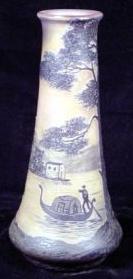
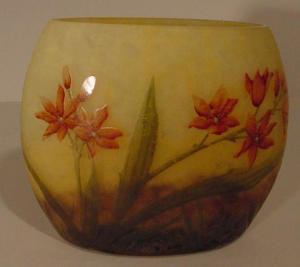
Cameo Glass
Cased Glass – The use of two layers of contrasting glass that are fused together to create one piece. The inner layer may be blown into the outer layer while the formed glass is still hot, or the piece in one color may be dipped into the molten glass of another color while it is hot. Cameo glass (see above) is a form of cased glass.
Cast
Figure Mold – a
type of glass mold that is cast directly from a sculpted model, resulting in the
transfer of very fine details to the mold without the need for additional
milling. Reuben Haley is credited with the perfection of this technique and used
it to produce his Martele (‘hand wrought’) line of glassware.
Chip
Mold – a
type of glass mold where the pattern is cut or ‘chipped’ into the surface of
the iron mold with hammer and chisel.
Chop
Plate
– a large, flat serving plate; also called a salver by some companies.
Cobalt
– a very dark blue glass whose color is achieved by adding cobalt to
the batch.
Comport/Compote
– a
small, opened candy dish that is stemmed.
Console
Set
- A three-piece tableware set generally composed of a pair of candlesticks and a
center bowl. These sets in pressed
and mold-blown glassware were especially popular in the 1920s and 1930s.
Cracker
Jar
– (biscuit jar) decorative Victorian counterparts of the modern cookie jar. Produced in china as well as glass, they are often rounded
barrel-shaped pieces fitted with silver plate rim, cover and bail handle.
Crackle/Craquelle
– sometimes
called “Iced Glass”. Hot glass is plunged into cold water and then mold
blown or free blown to the desired shape, resulting in very fine web-like cracks
on the outer surface of the article, while the interior is smooth.
Cranberry
– a
transparent reddish pink colored glass originally produced from the 1820’s
through 1880’s. The color was achieved by adding small amounts of gold oxide
to the batch.
Crimping
- A method of decorating the rims of bowls and vases.
While the glass was still hot, the glassworker would manipulate the shape
with a special tool, often forming a ruffled or ribbon-like design around the
edge.
Custard
–
a variation of milk glass ranging in color from a rich, creamy yellow to a bone
white. The glass is opaque and possesses a fiery opalescence. As Uranium salts
were use in its manufacture, old custard glass will glow under black light and
set Geiger counter needles in motion.
Domino
Tray – a
round tray with a center ring to hold a creamer and the remaining space serves
to hold sugar cubes. Named for the
“Domino Sugar Company”, these trays were produced by Depression glass
manufacturers from the late 1920’s through the 1930’s.
Enameled
Decoration
- A form of decoration used on many types of Victorian
Art
glass. White or colored enamel
paints were generally hand-painted on a finished piece of glass, which was then
refired to bake-on the enamel decoration.
Epergne
- French term used to describe a special decorative vessel popular during the
19th century. It generally consists
of one or more tall, slender trumpet-form vases that fit into the center of a
wide, shallow bowl base. The bowl
may be flat, footed, or raised on a pedestal foot.
Etched
Mold
– a type of glass mold where the pattern is etched rather than cut into the
surface of the mold using acid. This type of mold produces very fine detail in
the pressed pattern on the glass.
Etching
- design cut into glass; the two main types are acid etching and needle etching.
(See entries)
Fired
On – color
applied to the surface of an article then baked to fuse the color to the glass
permanently. This technique may be used to color an entire piece or to highlight
the details.
Fire-Polishing
- A process used to finish mold-blown and pressed glass where a piece is
reheated just enough to smooth out the mold seams without distorting the overall
pattern.
Flashed
On
- The use of a transparent colored stain to highlight an item of crystal glass.
After the stain – usually ruby or amber in color – is applied, the item is
reheated to fuse the stain to the surface of the glass. Flashing tends to wear
off as opposed to fired on color, which does not wear off with use.
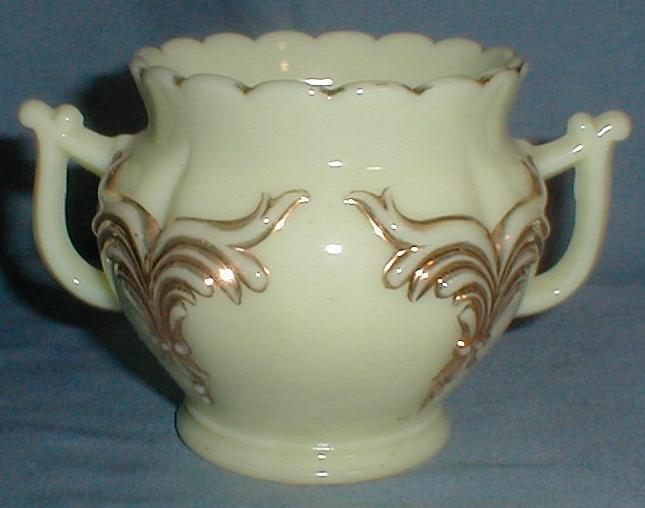
Custard Glass
Frog
– heavy
glass disc with holes for flower stems. Frogs were made to fit into the neck of
a vase or across the opening of a bowl to support the stems in an arrangement of
flowers. Some frogs (called Figural Frogs) have a statue in the center
surrounded by holes.
Gather
– a ball of molten glass that the glassblower ‘gathers’ on the end of a
blowpipe or punty rod.
Grill
plate
– a plate with raised ridges that divide the surface into 3 sections to keep
food separated. They were made popular in Grills and Diners during the 1920’s
– 30’s, thus the name.
Handkerchief
Vase
- A form of vase most often seen in 20th century Venetian glass where the sides
of the piece are pulled straight up and randomly pleated to resemble a large
handkerchief.
Hot
Metal Man – person
who formulates and supervises the mixing of batches in a glass factory. Also
called the ‘Batch man’ or ‘Color Man’, he was the person responsible for
creating the formulas for the different colored glass each company produced. As
these recipes were highly guarded secrets, a good hot metal man was the key to
the success of the glass company.
Iridescence
–
a shiny, rainbow-like finish on the surface of a piece of glass. The effect was
achieved by spraying metallic salts on the still hot glass and refiring the
piece. Different effects were achieved by varying the color of the underlying
glass and the combination of metallic elements.
Ice
Lip
– a guard or folded molded around the lip of a pitcher to prevent ice from
falling into the glass while pouring from the pitcher.
Jack-in-the-Pulpit
Vase
- A form of vase with the rim manipulated to resemble the wildflower of the same
name. Generally, the back edge is
curled up while the front edge is curled downward.
Knop
- Another term for a ‘knob’ usually referring to a finial on a lid or a
bulbous section on the stem of a goblet or wineglass.
Lampwork
- Referring to forming delicate objects out of thin rods or canes while working
at the lamp (small torch) or a small flame.
Latticino
– An Italian term for the art of embedding spiral threads of white or colored
glass in clear crystal. The technique dates back to glassmaking in the Roman
Empire and is the most distinctive technique used in Murano glass today.
Lattimo
- The opaque white glass, or milk glass (latte-milk), that resembles porcelain
when used to case or form a vessel. It is also used in various filigree
techniques.
Milk
Glass
– white glass, named for the color of milk. Early milk glass shows opalescence
when held to the light.
Millefiori
- An Italian term meaning “Thousand Flowers”, this glass was also called
“Tessera” or tile work. Glass rods are cut into discs, placed into a mold in
a particular pattern and then refired until fused. The technique is found on
plates, vases, and bowls and in the interior of paperweights.
Mold/Mould
– encasement into which hot glass is poured or blown to form an object. A
pattern is made in wood or plaster that is sent to the metal foundry where a
rough iron cast is made. The mold is then milled, shaped and finally the design
is cut or etched into the surface. (See Chip Mold, Etched Mold, and Cast Figure
Mold)
Mold-Blown
- A method of glass production where a gather of molten glass is blown into a
patterned mold to produce an object such as a bottle or vase.
Mold-Pressed
(or Press Molded) – a
method of glass production where molten glass is poured into a mold and a
plunger is brought down which presses glass into all parts of the mold.
Nappy
– another
word for a bowl.
Needle
Etching - is a 20th century technique where a hand-held or mechanized
needle is used to draw a fine-lined design on a piece.
Ornate repetitive designs were possible with the mechanized needle.
Novelty
- A pressed glass object generally made in the form of some larger item like a
hatchet, boat or animal. They were
extremely popular in the late 19th century with many produced as match holders,
toothpick holders and small dresser boxes.
Opal
-
Pronounced ‘o-pal’, this was the term used in the 19th century to
describe the solid white glass today known as milk glass.
Opalescent
– semi translucent, milky white glass that shows orange (or fire) when held to
a strong light. Opalescent glass is often found around the edge of a piece,
flowing into another color glass.
Ormolu
– decorative
metal adornments added to a glass item.
Overshot
– type of glass produced by rolling the gather over a steel plate covered with
minute glass particles. The gather was reheated to melt the sharp edges of the
fragments and then blown to the finished size. The resulting item had
contrasting color specks and a slightly rough surface texture. In rarer
examples, the gather was first blown to shape and then rolled in the fragments
without being refired. The surface on such pieces is quite uneven and sharp to
the touch.
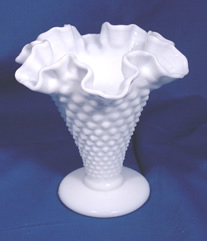
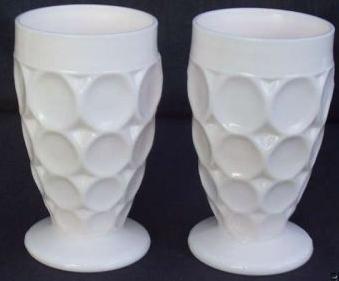
Milk Glass
Piedouche
- French term referring to a paperweight that is raised on a low, pedestal foot.
Pontil
Mark
- The scar left on the base of a glass article by the pontil or punty rod.
The hot glass object was attached at the base to the pontil rod so the
glass blower could more easily handle it during the final shaping and finishing.
When snapped off the pontil, a round scar remained which, on finer
quality pieces, was polished smooth.
Punty
Rod /Pontil
Rod – metal rod that the glassmaker
attaches to the bottom of an article to facilitate handling of the hot glass.
Rigaree
- Applied ribbon-like crimped decoration which highlights some types of
Rose
Bowl
– small, curved-in edged bowl, having a small center opening and usually
tri-footed. Widely popular in the late 19th century, rose bowls were
designed to hold small rose blossoms or rose petal potpourri.
Ruby
Glass – Glass
industry term for dark red,
transparent glass.
Salver
– a
large, non-handled serving plate, usually 11 to 13 inches in diameter. (See Chop
Plate)
Satin
– finishing
technique where the surface of an item is exposed to hydrofluoric acid to
produce a smooth, velvet-like texture. (See Acid Finish)
Scalloping
- A decorative treatment used on the rims of plates, bowls, vases, and similar
objects. It was generally produced
during the molding of the object (unlike crimping which is done by hand after
the piece is molded) and gave the rim a wavy or ruffled form.
Serrated -
A form of notching on the rims of glass objects which resembles the edge of a
saw blade. Sometimes referred to as
a ‘sawtooth edge’, it is usually found on cut glass pieces.
Shop
– Glass
industry term for a crew of people that worked together to produce hand made
glass items.
Silver
Deposit/Silver Overlay – The deposit of thick metallic silver on
glass by means of electrolysis. The design was painted on the glass with a wash
of borax, oxide of lead, sand, nitrate of potash, white arsenic and phosphate of
lime mixed in turpentine. The piece was fired to set the pattern, submerged in
an electroplating bath to deposit the silver, and then buffed and polished.
Sickness
- A term referring to cloudy staining found in glass items, especially bottles,
decanters and vases. Sickness
occurs when a liquid is allowed to stand in a piece for a long period of time
causing a chemical deterioration of the interior surface. Some sickness can be
‘cured’ by thorough cleaning, though in worse cases, only re-polishing the
surface will restore the luster.
Spall
- A shallow rounded flake on a glass object, generally near the rim of a piece.
Spatter
– a
spotted or multi-colored glass usually having a white inner casing and a clear
outer casing. Like Overshot glass, Spatter is produced by rolling the gather in
minute glass particles; but Spatter is then cased to produce a smooth surface
where Overshot glass is uneven or rough to the touch.
Stemware
- A general term for any form of drinking vessel raised on a slender pedestal or
stemmed base.
Teardrop
- A deliberately placed inclusion in a piece of glass, formed by a bubble of
air. They are often used to
highlight the stopper of a decanter or in the stems of goblets, and other
stemware.
Tumble-Up-
a
glass bottle with a long neck that has a small tumbler seated upside-down over
the top. The tumbler served as the stopper for the bottle as well as a drinking
glass/ Tumble-up sets were usually placed on a nightstand by the bed.
Turn
– Glass
industry term for the shift worked by a shop (glass crew) A turn was measured by
a quota of glass it was expected to produce, not by a set amount of time. (I.e.
300 pieces rather than 8 hours per turn.)
Vesica
-
A Cut glass term referring to a cut design in the form of a pointed oval.
Water Set - A tableware set consisting of a large pitcher and six or
more matching tumblers or goblets. Sometimes a matching tray was included with
the set.
Whimsey – A non-production glass item often made by the glassworker as a special gift for a loved one. The worker would take a standard production item and rework it to suit his fancy – or whim – making a one of a kind piece. Whimsies are also called ‘Lunchpail Pieces’ as the workers made them during their lunch or free time and were permitted to bring home items that fit in their lunch pail. As these items are unique, they bring high prices when found.